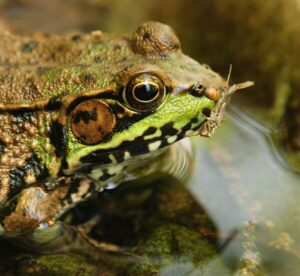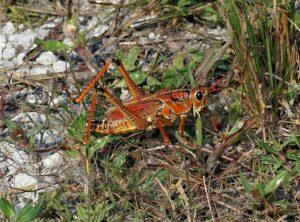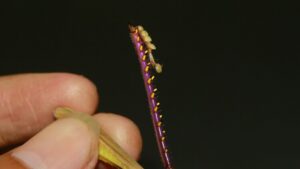Frogs are generalist carnivores that feast on worms and a wide variety of bugs. They are even known to eat bees, wasps, and other stinging eating. But do frogs eat grasshoppers?
In general, frogs eat grasshoppers. However, some grasshopper species such as the eastern lubber grasshopper are poisonous and foul-tasting, so most frogs will avoid eating them.
Poisonous grasshoppers usually advertise that fact to predators by having bright or contrasting colors. This is known as ‘aposematism ‘or ‘warning coloration.
A frog that eats a brightly colored poisonous or foul-tasting grasshopper will remember the experience.
The next time that predator sees another similarly colored grasshopper, it will associate the colors with danger and learn to avoid eating that species.
Frogs Can Eat Most Grasshoppers & Their Nymphs
Frogs are opportunistic predators with very diverse diets. Smaller frogs mostly eat small worms and a wide variety of bugs, but large frogs such as bullfrogs will also eat smaller amphibians, small lizards, mice, and even small snakes!
If the prey is slow enough to catch and small enough to fit into the mouth, it is on the menu – and grasshoppers are not off limits.

Most grasshoppers are perfectly edible and are not harmful or toxic to frogs in any way.
In addition to eating adult grasshoppers, frogs also eat grasshopper nymphs (baby grasshoppers).
Since grasshopper nymphs are smaller than adult grasshoppers, even frogs that are too small to eat adult grasshoppers can readily feast on them.
Eating grasshoppers in their immature stages is easier than eating adult grasshoppers, as the nymphs can not yet fly.
Some Grasshoppers Are Poisonous to Frogs
Although most grasshoppers are not harmful to frogs in any way, some grasshoppers such as the Eastern lubber grasshopper are poisonous.
Poisonous grasshoppers get chemicals from the plants they eat, and turn them into toxins they can use to defend themselves from predators. When approached by a predator (which may be a frog), these grasshoppers may spread their wings and hiss.
If this does not intimidate the predator, they can secrete a toxic foamy, slimy liquid with a nauseating smell and vomit a bitter bile tasting that’s slightly acidic.

If a frog eats a poisonous grasshopper, it may gag and regurgitate the insect, or sometimes even die due to the grasshopper’s toxin. For this reason, most frogs quickly learn to avoid eating poisonous grasshoppers.
How Do Frogs Catch Grasshoppers?
Frogs catch and eat grasshoppers the same way they eat other insects. They have sticky tongues that allow them to catch any moving insect that comes into range quickly.
Once a frog spots a grasshopper, it launches its tongue to catch the prey. After catching the prey, the tongue wraps around it and coats it with sticky saliva. The frog will then yank its tongue back with a force equal to twelve times greater than the force of gravity.
Once the grasshopper is in the mouth, the frog will swallow it whole (although frogs have teeth, they do not use them to chew, but rather to maintain a grip on their prey as they swallow it whole).
A frog can shoot out its tongue, capture an insect and pull it back into its mouth within 07 seconds; which is five times faster than the human eye can blink. This speed makes it effective at catching grasshoppers and even fast-flying insects such as flies.
Can Frogs Eat Dead Grasshoppers?
Frogs are instinctively attracted to movement while hunting for food. For this reason, most frogs will not eat dead grasshoppers or any other dead bugs.
In fact, many insects use playing dead as a way to avoid predators, including frogs. Some insects stop moving and stay perfectly still to prevent frogs from eating them.
Do Frogs Get Hurt When Eat Grasshoppers?
Grasshoppers have spines on their hind legs that they can use to defend themselves when threatened. In addition, most grasshoppers can use their jaws (mandibles) to bite if captured by a predator. However, these defenses will not be a problem for most frogs.

Once a frog catches a grasshopper, its long tongue wraps around it and coats it with sticky saliva – which immobilizes the insect. The grasshopper is then quickly swallowed.
Still, sometimes frogs get kicked or bitten when they try to eat grasshoppers, but this doesn’t faze most frogs, or stop them from eating grasshoppers in the future.
Are Grasshoppers Good or Bad for Frogs?
Grasshoppers are a rich source of protein, fat, fiber, and energy and can be a significant source of vitamins and minerals for frogs.
However, sometimes grasshoppers may be exposed to pesticides that can be harmful to a frog when the grasshoppers are eaten.
Once possible pesticides are taken out of the equation, eating non-toxic grasshoppers is not harmful to frogs in any way.
Can Captive Frogs Be Fed Grasshoppers?
In general, it is not a very good idea to offer wild grasshoppers to captive frogs. As mentioned earlier, wild bugs may be carrying pesticides that can be harmful to a frog. For this reason, it’s recommended to only give your frog captive-bred feeder insects.
You can feed your frog captive-bred grasshoppers and locusts. However, a challenge is that most stores that sell feeder insects do not stock live grasshoppers.
Still, you can find a supplier that sells live feeder grasshoppers if you look hard enough – it could even be another hobbyist.
Alternatively, you could culture grasshoppers at home if you are up for the challenge.
Here is a list of other things you can feed a captive frog:
- Worms (earthworms, whiteworms, blackworms, etc)
- Mealworms, Waxworms, Phoenix worms, Silkworms, superworms
- Maggots
- Crickets
- Dubia roaches
- Wingless fruit flies
- Feeder Fish
- Pinkie mice (for large frogs such as bullfrogs)
The most appropriate food will depend on the size and species of the frog. For example, some tree frogs won’t eat mealworms, but will readily eat crickets and wingless fruit flies.
Large frogs, such as bullfrogs enjoy the occasional “pinkie” in their diet. A “pinkie” is a tiny, baby mouse. You can find them in pet stores either alive or frozen although it can be difficult to get frogs to eat the dead/frozen ones.
A varied diet is recommended, so be sure to change up the food items offered to the frog every few feedings.
What Other Predators Eat Grasshoppers?
Frogs and toads are not the only animals that eat grasshoppers. Grasshoppers are also preyed on by fish, lizards, turtles, tortoises, spiders, mice, a wide variety of birds, wasps, hornets, Mantises, and even small snakes such as Garter snakes.
Additionally, in some regions of the world – such as the Philippines, Thailand, and parts of Africa; grasshoppers and locusts are collected and eaten by humans.
Scientists know approximately 8000 grasshopper species, of which an estimated 80 species are consumed by humans.
In fact, grasshoppers are among the top 5 most eaten insect species (by humans) around the world
Frequently Asked Questions
Can a frog eat a grasshopper? A frog can eat a grasshopper if it is small enough to fit into the mouth, and is not poisonous or foul-tasting. Some grasshoppers are poisonous, so most frogs will avoid eating them. Poisonous grasshoppers usually let frogs, and other predators know they are toxic by having bright colors.
Do toads eat grasshoppers? Toads eat grasshoppers when the opportunity presents itself. However, some grasshoppers such as the eastern lubber grasshopper are toxic or foul-tasting, so most toads will avoid eating them. If a non-toxic grasshopper flies or sits close to a toad, the toad will eat it
Conclusion
Frogs can and do eat grasshoppers, both in the wild and when kept as pets in captivity. Grasshoppers provide protein, fat, fiber, and a wide range of vitamins and minerals for frogs.
Do bear in mind that frog species and size will determine what kind of grasshoppers a frog can and cannot eat. Small frogs will only eat small grasshoppers, but large frogs can eat larger grasshoppers.
Poisonous grasshoppers warn frogs they are toxic by having bright colors. Of course, a frog has to learn to associate the bright colors with a bad meal, so a few toxic grasshoppers will be sacrificed until the frog gets the message.


